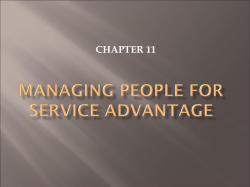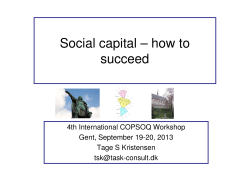
Convergys Content - Ovum Industry Congress
The Shifting Sands of Satisfaction Consumers are now totally connected—and totally demanding. Is “effortless” the new satisfaction? They expect the right service at the right time, in a place that is convenient for them. The common denominator in the majority of dissatisfied interactions is the level of effort required by the consumer to get to a resolution. Consumers want companies to adapt to their needs, to engage them in a way that suits them, and to take the initiative in building a trusting relationship that aligns closely with their values (e.g., charitable donations, use of fair trade products, etc.). This sense of “satisfaction” is an elusive, fascinating, and ever-changing collection of moments that lead to loyalty. Our paper, The Changing Face of Loyalty, argues that you are rarely rewarded for exceeding expectations, but you are heavily penalised for dissatisfaction. To use an analogy, dissatisfaction acts as a hole in the bucket of satisfaction that you are providing over time. Therefore, the best road towards building greater loyalty is to eliminate these areas of dissatisfaction. Top three reasons for dissatisfaction So where do you look for the roots of dissatisfaction? The 2014 Convergys Customer Scorecard Research* shows that they remain largely unchanged since 2009. The top three reasons for dissatisfaction are: 2. Had to call multiple times (37 percent) In a recent analysis, Convergys found that 73 percent of the consumers who rated their agent a “10” in terms of delivering a good experience also classified themselves as promoters of the company. But that promotional behavior fell off quickly as agent-satisfaction scores dropped. Reasons for Dissatisfaction in Most Recent Interaction 45% 37% 34% 29% 24% 23% 19% 16% In a world of multiple touchpoints (voice, email, chat, apps, web, even text) you are not, necessarily, in control of where the customer initiates contact. However, if done correctly, you will not be penalised unduly for asking customers to switch channels—providing it leads to a successful outcome. On the other hand, an unsuccessful outcome (whatever the channel) will lead to you being heavily penalised by that customer in a satisfaction score, ultimately impacting loyalty and spend. 64 % 40 % 31 % 14 % Percent CSAT with Most Recent Interaction MADE MORE THAN ONE CONTACT 2+ contacts USED MORE THAN ONE CHANNEL 2+ channels HAVE BEEN A CUSTOMER FOR 10+ YEARS DO NOT GET GOOD VALUE FOR THE PRICE 1 contact 1 channel 68% 80% 69% 74% 10+ years tenure 74% <10 years tenure 71% Not good value 18% Good value 91% Figure 2. Experiences that happened yesterday often taint satisfaction today. Mind the gap—manage the transitions 18% 17% 15% Creating a good outcome whatever the channel Customer History 3. Took too long to resolve (34 percent) 16% Furthermore, research shows that reducing this effort, along with the appropriate, relevant communication (which we will come onto) and alignment to values, will greatly increase satisfaction. The trouble is that, in many situations, channel switching is not elegant and can often contribute to the three biggest reasons for frustration. Overcoming these must be a priority. 1. Had to repeat myself, including providing the same information in multiple channels (45 percent) Had to repeat myself Had to call multiple times Took too long to resolve Rep not empowered Had to use different methods Hard to reach service Bad billing Tried to upsell Won’t fix overcharge Rude, disrespectful Rep didn’t listen No follow through Can’t understand accent Thus reducing this consumer effort has a significant impact on reducing dissatisfaction. EFFORT AGENT COMPANY 14% Figure 1. Five of the top six reasons for dissatisfaction are effort related. You have probably implemented hot-swaps in your call centres—one agent passing all relevant information over to another so that customers do not need to repeat themselves or go through security again. But have you been able to implement hot-swaps between your technology-based interfaces and your people-based interfaces? The Shifting Sands of Satisfaction Given that the starting point for a customer engagement can be at one of any number of touchpoints, to make the experience effortless, you need to understand and measure their journey across the different platforms, and importantly, the crossover between platforms. So, if a customer sends you a text with a complaint (11 percent prefer text to email), then how slick is the experience they receive if you ask them to call you? Also, if they call from the same number they have texted you from, will they go straight to the right person to resolve their initial request? Or will they just go to the central team and be taken through several levels of agents to get to a resolution? Similarly, what happens if they contact you whilst already logged onto their account online? A UK bank (famed for its telephone support) struggled with this. Security restrictions meant that the agent and the customer could not be logged on to the account at the same time, meaning they couldn’t look at the data together—the customer would be told to log off. Yet some industry estimates show that around a third of consumers are still on the provider’s website as they call. Measuring customers’ effort—not yours Maybe chat could have a greater part to play in plugging the channel gap than it currently does? Certainly our own research shows that convincing consumers who said they preferred to use the phone to use chat instead is definitely possible, especially if chat were seen as more accessible, faster, and easier to use. Measuring your effort in delivering customer service is no longer enough. You need to measure their effort in dealing with you across multiple touchpoints. As customers move from one channel to another, you need to be able to follow them and measure the effort they require to put in for you to 2 service them. By effective journey mapping, you will be able to identify and pre-empt potential excessive effort involved in crossing channels. In our related paper, Metrics That matter, we go further into how to measure customer effort so that it can be reduced. Supporting European diversity The cultural differences in Europe create different challenges for customer services. These even extend to the online world. Previous research has shown that you can expect to see different perceptions of consumer effort by region, by country, or even by industry by country. We know that in the world of e-commerce there are variations, such as the French and Spanish being most vexed by not being able to speak to someone during a transaction. The Germans identify poor checkout processes as being their biggest bugbear, and for the UK, a large part of frustration comes from the logging in/account management stage. Again, each of these is effort related. Reducing customer effort overall will produce higher satisfaction levels and increase loyalty and spend. Some in-country solutions may need special attention, to incorporate cultural and legislative nuances. Minimising customer effort can be combined with other traditional customer satisfaction techniques. These include reducing failure demand (the customer chasing something that should have happened but hasn’t) and win-win personalisation (only asking for personal information at an appropriate point and only to create a positive outcome for the customer, and only communicating the things they have asked for). Undertaking these measures together should result in customer satisfaction levels rising sharply. Satisfaction may be elusive, fascinating, and ever-changing, but it is achievable. *2014 Convergys U.S. Customer Scorecard Research ■■ 2,808 surveys among U.S. consumers aged 18-74 years using an online research panel ■■ To qualify, respondents must have had at least one interaction with a qualifying industry in the six months prior ■■ Data were weighted for age and gender based on the 2010 U.S. Census ■■ Bank (n=358), Credit Card (n=397), Healthcare Insurance (n=364), Internet Service Provider (n=266), Retailer (n=406), Satellite/Cable TV (n=251), Mobile Service (n=290,) and Technology (n=477) ABOUT CONVERGYS Convergys delivers consistent, quality customer experiences in 47 languages and from more than 150 locations around the globe. We partner with our clients to improve customer loyalty, reduce costs, and generate revenue through an extensive portfolio of capabilities, including customer care, analytics, tech support, collections, home agent, and end-to-end selling. We are committed to delighting our clients and their customers, delivering value to our shareholders, and creating opportunities for our talented, caring employees, 125,000-strong in 31 countries around the world. Visit convergys.com to learn more about us. ©2015 Convergys Corporation. All rights reserved. Convergys and the Convergys logo are registered trademarks of Convergys. TL020A4 3-11-15 FOLLOW US ON: 1.800.344.3000 (US) 1.513.458.1300 (Int’l) www.convergys.com 201 EAST 4TH STREET CINCINNATI OH 45202 UNITED STATES
© Copyright 2025









